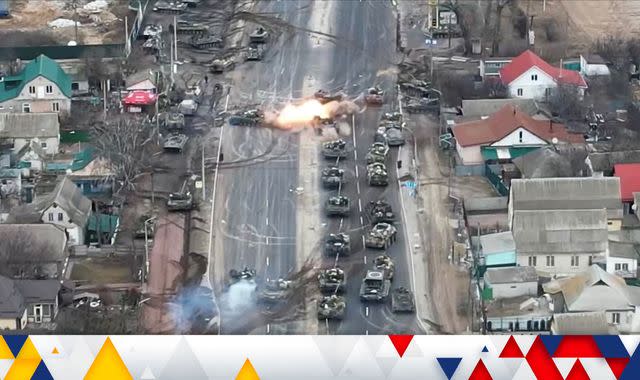Yes, but in the context of this thread, on the defence the infantry should be dismounted anyways, so the topic at hand isn't really an issue.
But how much preparation do you have to prepare a hasty defence, or for that matter a hasty attack? At what point do you sense a change in the situation that suggests the change from a mounted course of action to a dismounted course of action?
Do you want to make good time and accept risks?
Or do you want to minimize risks and accept a slow pace?
Are you going to push out advance, rear and flank guards and adjust to the terrain or highball it down the middle of the road?
Drone footage shows a Russian tank column coming under fire on the outskirts of Kyiv. A Russian tank commander was killed in the attack in the town of Brovary, the Ukrainian military claimed. The footage, taken from a Ukrainian drone, shows three Russian tanks in the village of Skybyn before...

ca.movies.yahoo.com
Other examples?
Column moving widely spaced on a two lane highway in open fields with hedgerows being plinked apart with precision.
Vehicles bunched up for a river crossing.
Generals being chased out of HQs by artillery raids.
Helicopters and Generals being destroyed by 20 strikes on the same parking lot.
Batteries being forced to disperse into two gun sections because 6 gun batteries are too tempting a target?
I seems to me the TAPV with RWS and 4 dismounts - 4 to 6 of them to every company/battery in the field would make a useful security det. In other words every company or battery - guns, rockets or AD, trucks, helos, maintenance or command, should have its own, or should be able to field its own, "infantry/CRAM" platoon to be able to protect the sub-unit while on the move and also, while static and performing its primary function.
Lots of opportunities for Reserve Infantry and Cavalry tasks - VP defence and LOC security. Lots of reasons for all arms to maintain General Duties soldiers on their rolls. Soldiers that can be learning their primary trade at the same time they are providing security.
Or do we anticipate drawing Chariots of Fire, with their assaulters, from the assault force to disperse around the rear as security forces?
It seems to me that if the Chariot is primarily intended to be an Assault vehicle then that will demand one set of characteristicss On the other hand a General Duties/Utility/Security vehicle will have different needs. I doubt we can afford to use assault vehicles throughout the entire rear area and if we try we would end up with one vehicle that is a less than ideal assault vehicle and both too few in number and too expensive, not to mention over equipped to be a utility vehicle.
Perhaps something like this for the rear security vehicle instead of, or in addition to, the TAPV?

militaerfahrzeuge.ch
With that out of the way - 4 to 8 of them in every security platoon? - with that out of the way then what do you require for an Assault Vehicle?



